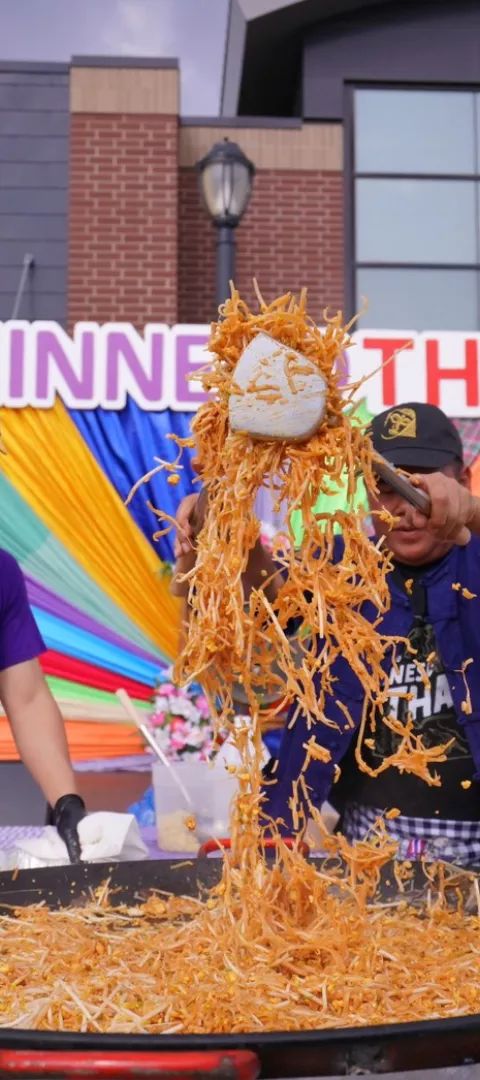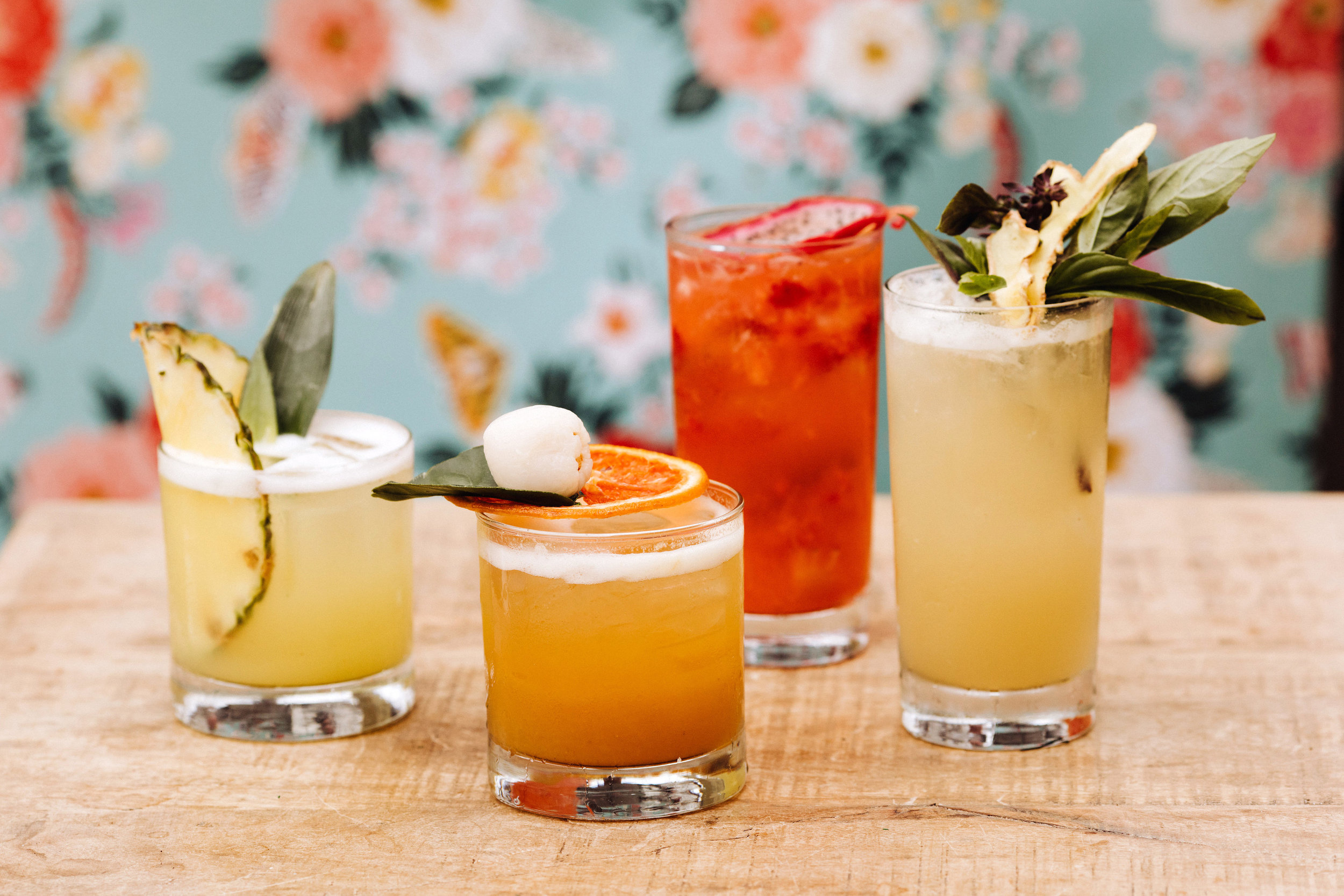
15 Ways to Support and Celebrate Minnesota’s AAPI Community
15 Ways to Support and Celebrate Minnesota’s AAPI Community
By Macy-Châu Diễm Trần
Whether it is escaping war or seeking opportunities, many Asian American and Pacific Islander (AAPI) communities have long made Minnesota a hotbed of mouthwatering eats, vibrant festivals, and breathtaking art.

Traditional Hmong foods on display at Hmong Village in St. Paul / J. Annie Wang
Asians and Pacific Islanders span 75 countries across Asia and the Pacific Islands, each with dozens if not hundreds of its own ethnic groups, languages, and cultures. The majority of AAPI Minnesotans identify as Southeast Asian, including the Hmong, Vietnamese, and Laotians who arrived during the ‘70s and ‘80s, and recent Karen and Karenni refugees from Myanmar.
Here are 15 of our favorite ways to experience and embrace the state’s rich cultural fabric firsthand.
-
Shop at a street-style market
Little Mekong Night Market / Andrew Parks
Shop at a street-style marketOnce a summer, the Little Mekong Night Market transforms one of St. Paul’s most dynamic cultural districts into a lively Southeast Asian-style night market. Support South Asian small businesses by shopping for traditional art, clothes, and food at the SEWA-AIFW winter holiday and spring bazaar. For something all year round, experience a thriving indoor marketplace at Hmong Village, packed with crafts, traditional medicines, and wares from Southeast Asia.
-
Appreciate performance art

CAAM Chinese Dance Theater
Appreciate performance artThe AAPI diaspora uses performance art as a tool to tell their stories and connect to cultural rituals and traditions. Watch a play or musical from Theatre Mu. For dance, check out CAAM Chinese Dance Theater or Jangmi Arts, home to traditional Korean dance and music.
More interested in AAPI music? Enjoy a Japanese drum performance by TakioArts Midwest. During Taiwanese Heritage Week in early June, the Taiwanese American Association of Minnesota organizes a yearly show with visiting performance artists from Taiwan. If you’re looking to learn, these organizations also offer workshops and classes.
-
Dine at critical darlings

Four of the fantastic cocktails you'll find at Hai Hai
Dine at critical darlingsBreaking barriers and bringing AAPI food to the forefront of fine dining, Minnesota is home to numerous James Beard nominees. Most recently, Hai Hai chef Christina Nguyen championed Southeast Asian street food (and some of the city's best cocktails) by taking the title of Best Chef of the Midwest.
Check out other critically acclaimed establishments including Khâluna for elegant Laos and Thai eats, Union Hmong Kitchen for nourishing Hmong comfort food, Diane’s Place for Asian fusion croissants and Hmong-inspired brunch, and Marc Heu Pâtisserie Paris for stunning and creative sweets.
-
Study a second language

Twin Cities Chinese Language School
Study a second languageLanguage is integral to preserving AAPI culture in the U.S. Consider Truong Viet Ngu for youth and adult Vietnamese classes. The SEAD project additionally offers Khmer and Hmong courses for adults. For all ages learning, the Korean Institute of Minnesota and the Twin Cities Chinese Language School teach Korean and Mandarin Chinese. The School of India for Languages and Culture teaches nine South Asian languages, including Hindi, Tamil, and Bengali. Additionally, the Association of Nepalis in Minnesota organizes Youth Nepali language and culture classes.
-
Eat to your heart’s content

MinnesoThai Street Food Festival
Eat to your heart’s contentMinnesota’s abundance of AAPI food festivals makes it easy to sample many different cuisines without leaving the state. Appreciate the complexities of kimchi at Adoptee Hub’s annual Kimchi Festival in the fall, or feel the heat of fiery woks at the MinnesoThai Street Food Festival. For a little bit of everything, wander the Asian Street Food Night Market in St. Paul.
-
Dress to impress

VSAM's Tết Show
Dress to impressWith its bright patterns, handwoven textiles, and gold and silver embellishments, AAPI fashion spotlights seemingly endless shades of creativity and style. To appreciate and learn more about these dazzling garments, try the annual Lao fashion and dance show, organized for Lao New Year.
At a similar time is the Queer & Trans and Their Friends: Cambodian New Year Runway Show, an LGBTQ+ inclusive fashion show showcasing apparel made by Khmer American makers across the country. Around Lunar New Year, check out the Vietnamese Student Association of Minnesota’s annual Tết Show, featuring a packed line up of contemporary and traditional local fashion.
-
Experience time-honored traditions

Dragon Festival
Experience time-honored traditionsEvery summer the Japanese America Society of Minnesota organizes the Japanese Obon Festival at Como Park, where attendants light water lanterns to honor their ancestors. Witness a one-of-a-kind race at the Dragon Festival on July 13, complete with elaborately designed boats and a little friendly competition.
Later into the fall, the Hindu Society of Minnesota organizes celebrations for its Festival of Lights, showcasing global Diwali traditions. Around the same time, attend Durga Puja, a three-day Bengali Association of Minnesota festival filled with ritual, food, and performance to honor the goddess Durga, celebrating her victory of good over evil.
-
Commemorate freedom movements

Hmong International Freedom Festival 2024 / The United Hmong Family, Inc.
Commemorate freedom movementsMany AAPI communities carry a history of fighting for freedom and independence. The Hmong International Freedom Festival is one of the largest gatherings of the Hmong diaspora in the country. It’s held at McMurray Fields in Como Regional Park every summer, and is centered on such competitive sports as soccer, flag football and volleyball.
Another major summer gathering is Philippine Day, which is hosted by the Cultural Society of Filipino Americans. The India Association of Minnesota commemorates India’s Independence Day at the State Capitol with IndiaFest, where you can enjoy Indian handicrafts, textiles, and flavorful food. Finally, celebrate Indonesia’s independence from the Netherlands with Indonesian Independence Day towards the tail end of summer (August 18 this year).
-
Complete a food crawl

Trung Nam French Bakery
Complete a food crawlHave no fear if you can’t make it to all of Minnesota’s annual festivals! The Little Mekong District in St. Paul is a year-round cultural hub and food paradise. Whether it’s Thai street food at Hot Grainz, Vietnamese croissants and banh mi at Trung Nam French Bakery, or crispy pork belly at Tai Hoa BBQ, the Little Mekong District meets your every craving.
-
Find arts and crafts inspiration

XIA Gallery and Café
Find arts and crafts inspirationAAPI artists and craftspeople have always been pillars of culture, tradition, and history who use diverse mediums to understand their identities and share stories. Enjoy the rotating exhibits at XIA Gallery, and buy gifts from their shop to support local API artists. Visit the Hmong Museum, the first of its kind honoring and preserving Hmong history and art. The museum also organizes craft workshops, including Hmong Batik textile dyeing and Hmong cross-stitch.
-
Learn about emerging immigrant groups

A hot bowl of Mohinga at Mandalay Kitchen
Learn about emerging immigrant groupsThe Karen are an ethnic group indigenous to Myanmar, and a fast growing AAPI group in Minnesota due to an ongoing civil war. Home to the largest Karen diaspora in the country, Minnesota is rife with Karen food and community festivals.
For a new cultural experience, try celebrating the Karen New Year with the Karen Organization of Minnesota. Eat affordable curries, samosa, and sticky rice at one of the numerous Karen grocery stores and delis in St. Paul, such as Kyaw Karen Market or Shwe Karen Market & Deli. Try Friends Cafe and Mandalay Kitchen for more of a restaurant experience/master class in Karen and Burmese food.
-
Ring in the New Year(s)
Songkran Festival 2023 at the State Capitol / Andrew Parks
Ring in the New Year(s)The AAPI community’s various New Year celebrations are an especially important time to honor lineage, tradition, and spirit. In December, the two day Minnesota Hmong New Year highlights Hmong dance, music, and crafts.
Falling between January and February, Lunar New Year is celebrated by Chinese, Vietnamese, Taiwanese, and Korean communities. The Vietnamese Community of Minnesota organizes their annual Lunar New Year celebrations with two full days of concerts, cultural performances and food. Look out for the International Minnesota Chinese School and Chinese Community Center’s two day Chinese New Year Festival, complete with lion dancing and lucky red envelopes. Tibetan New Year, Losar, closely follows after the Lunar New Year, with a multi-day festival in Isanti.
For Cambodians, Laotians, and Thais, New Year (also known as the water festival) is celebrated in April/May, and includes the Songkran Festival at the State Capitol and the Lao New Year Water Festival celebration with Siengkane Lao MN. Learn more about a new immigrant group to Minnesota and their traditions, by attending Kay Htoe Boe (Karenni New Year) in April with the Karenni Community of Minnesota.
-
Taste the island life

Ono Hawaiian Plates
Taste the island lifeFrom the islands to the mainland, Minnesota is home to a small but mighty diaspora of Pacific Islanders. Breaking into the Minnesota AAPI food scene is Ono Hawaiian Plates, serving island comfort food. You can find their fresh ahi poke bowl, smoky Hawaiian BBQ chicken, and shredded kalua pork at several locations across the Twin Cities, including North Loop’s Graze the grocery store United Noodles.
-
Honor places of worship

Watt Munisotaram / Andrew Parks
Honor places of worshipTucked away in Hampton, Minnesota is Watt Munisotaram, the nation’s largest Cambodian Buddhist temple. Ornately decorated across 40 acres of land, Watt Munisotaram is the heart of the Buddhist Cambodian community in Minnesota. The best time to visit is during Cambodian New Year in April, when the temple transforms its grounds into a bustling festival to celebrate the New Year.
The Hindu Temple of Minnesota in Maple Grove is also an impressive sight, with intricately designed architecture, including 21 mini replicas of famous temples from India. The temple organizes public yoga classes and festivals such as Holi.
-
Go grocery shopping

Hmongtown Marketplace / Paul Vincent
Go grocery shoppingThe Twin Cities metro area is chock full of AAPI-owned grocery stores for your next cooking adventure. For Chinese or Vietnamese-inspired cuisine, try Shuang Hur, Sun Foods, or Ha Tien Supermarket. Thai and Hmong ingredients are found at Good Deal Oriental or Hmongtown Marketplace. In the summer, Hmongtown Marketplace and Sun Foods’ St. Paul location boast vibrant farmers markets across their parking lots on the weekends.
Korean ingredients for your next kimchi starter are at Kim’s Asian Market and Dong Yang Oriental Foods & Deli. Little India International Market and India Bazaar sell the perfect spices for homemade curries or masala chai. You’ll get the best pan-Asian picks for your snack craving at United Noodles and Asia Mall. Many of these grocery stores also possess delis for hot-and-ready, affordable snacks and meals.















